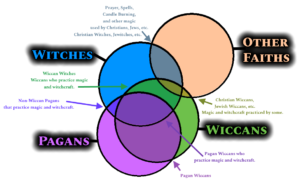Let’s start out with a general concept of how witchcraft relates to religions such as Christianity, Paganism, Judaism, Wicca, etc. Please note that we are looking at a broad scope here, and there are so many nuances in witchcraft that it cannot be completely illustrated with a simple Venn diagram as is shown in this lesson. What you should remember is:
- Wiccans are called Witches, although not all of them practice witchcraft (spells & magic).
- Most Wiccans are Pagan however, there are some who syncretically combine Christianity (Christian Wiccans), Judaism (Jewish Wiccans), and other faiths. There are also an increasing number of Agnostic Wiccans.
- Witchcraft and magic are practiced in every part of the world and by every faith. From prayers and blessings to spells and divination, humans have sought to understand and influence their lives through unseen forces for many thousands of years.

Witches are defined here as anyone who practices witchcraft such as spells, divination, or other forms of magic including prayer, blessings, purification rituals, etc.
Other Faiths include Christianity, Buddhism, Islam, Judaism, Hinduism, Native American Practices, etc.
Pagans are defined as neo-Pagans1 who are generally polytheistic, nature-based, and influenced by pre-Christian religions and practices. Polytheism is the belief in multiple deities.
Polytheism is generally separated into “soft” and “hard”. Soft polytheism is the viewpoint that the different Gods and Goddesses are different facets, personifications, or aspects of one divine force, or the Universal All. Soft polytheists might also believe that the deities are psychological archetypes or the personification of natural forces.
Hard polytheists adamantly reject soft polytheism and believe that the Gods are real divine beings, distinct and separate.
Wiccans are generally earth-based, have a reverence for nature, and might hold either “soft” or “hard” polytheistic beliefs. Often an individual will fluctuate between both in their lifetime. Their modern practices developed from Gerald Gardner in the mid 20th century, but because it is an evolutionary and syncretic practice, Wicca takes many forms and has a variety of traditions that show little similarity to Gardner’s original teachings. Traditions are called “trads” and are somewhat similar to the various denominations of other faiths like Christianity. For example, not all Christians are Catholic, but all Catholics are Christians. Much like not all Wiccans are Gardnerian, but all Gardnerians are Wiccans. Wiccans are generally nature-based and acknowledge a feminine deity. The vast majority of Wiccans practice witchcraft through rituals, spells, sigils, divination, etc. Most also abide by the Wiccan Rede and/or the Threefold Law.
As mentioned earlier, the Wiccan Rede is a bit of counsel or advice (the definition of the word “rede”). It helps to guide the Witch when she is unsure of what action to take. There are many versions of the Rede, but they are all variations of…
An it harm none,
do as you will.Where most Wiccans utilize the Rede, slightly fewer also believe in the Threefold-Law or Law-of-Three. This is more of an axiom than a law for most Wiccans. One of the foundational magical laws of the universe is “like attracts like”. Whatever you send out is returned to you. Some see this as it returning to you three times worse, or on three different occasions. For example, you throw a hex on someone and that negativity comes back to you thrice as bad.
Notes
The term neo-Pagan was in use for most of the 20th century by revivalists and reconstructionists (of old religions). In the 60’s it became increasingly used in the counterculture movement and was popularized by Oberon Zell-Ravenheart when he published the Church of All Worlds’ magazine entitled The Green Egg. He encouraged the use of neo (new) Pagan as a way to differentiate it from anthropological references.